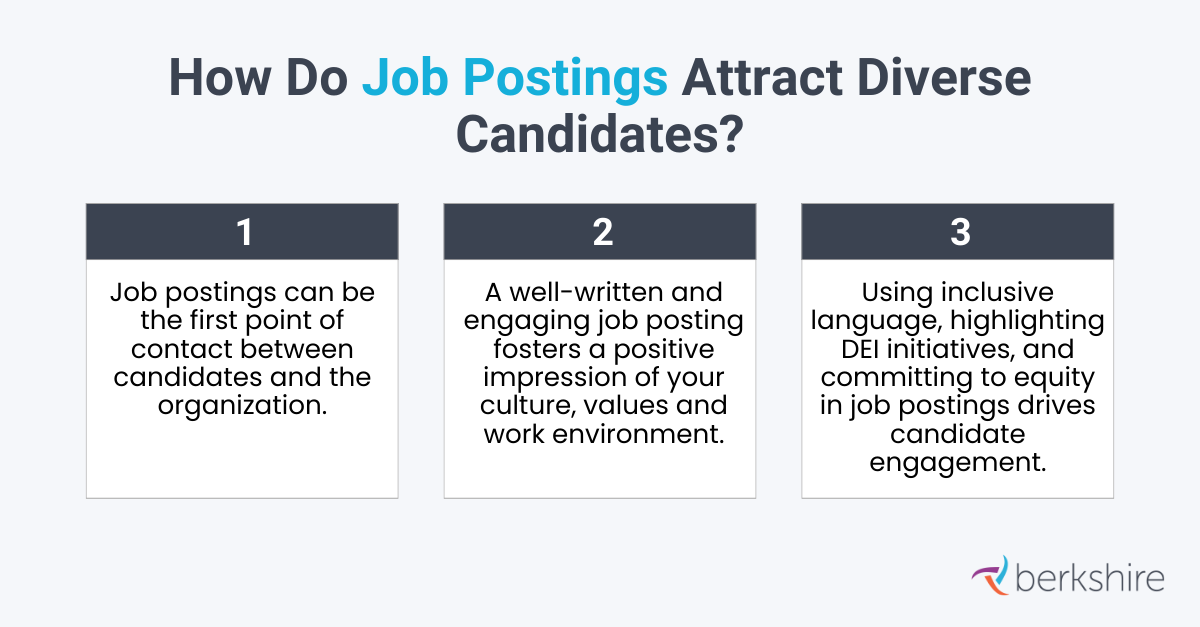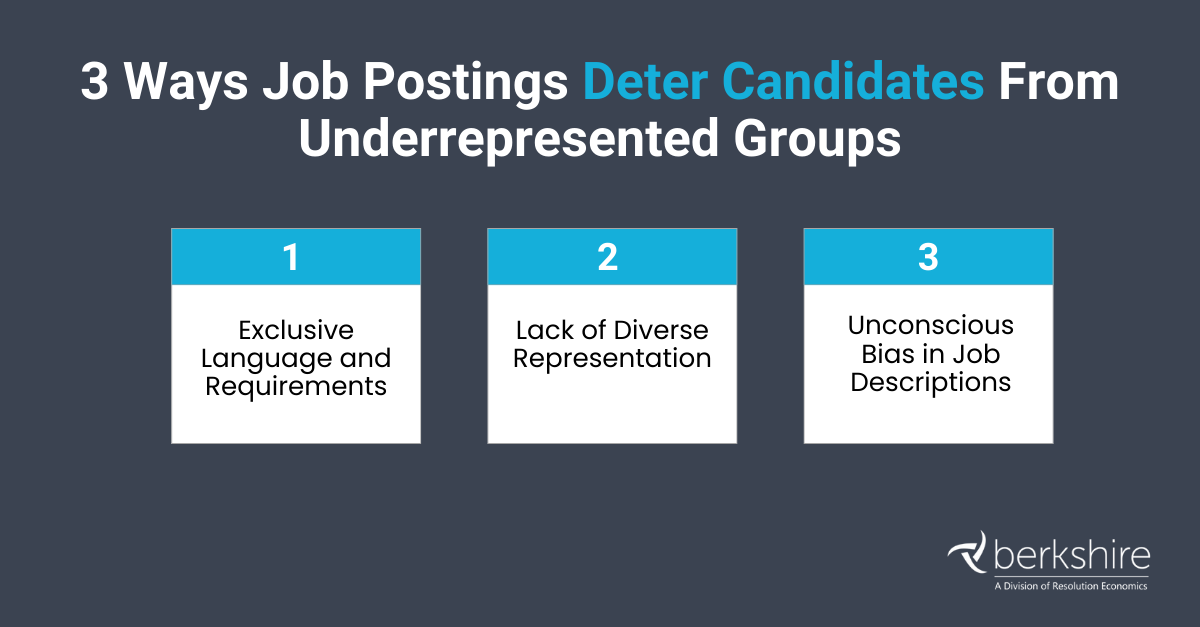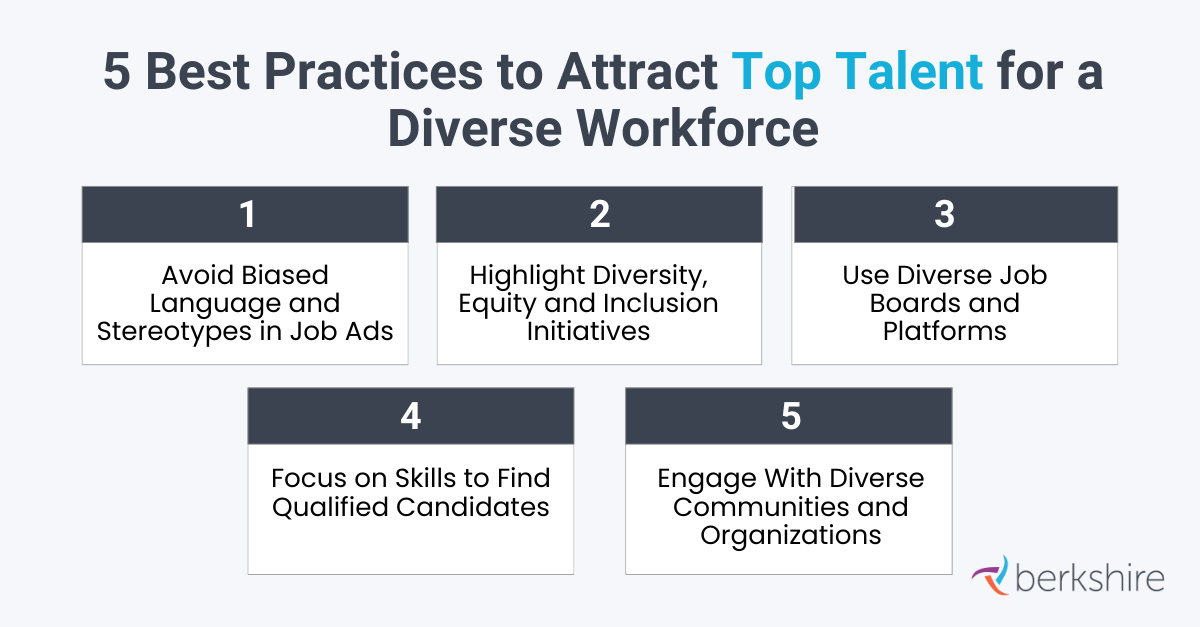Your careers site and job postings are often a candidate’s first interaction with your employer brand, and first impressions matter — especially when attracting top talent. So if you’re wondering how to attract a diverse pool of candidates, don’t overlook the power of a simple job posting. You can fashion job postings that attract diverse candidates to support your diversity hiring goals.
The right job posting in the right place can do wonders to attract the ideal candidate. However, it goes both ways — poorly conceived listings can deter strong applicants or unwittingly turn away certain demographics. If your job posting hurts your efforts at recruiting diverse candidates, that's a problem.
Learn why recruiting diverse candidates matters to your diversity, equity and inclusion strategy and how to attract diverse candidates through thoughtful, well-written job postings.
Why Is It Important to Attract Diverse Candidates?
Employees today place a premium on diversity, equity and inclusion (DEI) efforts. In fact, more than half (53%) of U.S. workers report that an organization’s commitment to an inclusive culture is a big factor in their decision to work there.
There are plenty of reasons candidates value DEI work so highly. A DEI-focused hiring strategy aims to create an inclusive environment where all employees have equal opportunities for growth and advancement. This, in turn, improves employee satisfaction, reduces turnover and enhances overall retention rates.
To attract the talent you need to sustain a successful business, you have to show candidates right from the start of your recruiting process that diversity, equity and inclusion matter. That requires a keen attention to detail when creating and posting job ads on your careers site, job boards or social media channels.
How Do Job Postings Attract Diverse Candidates?
Job postings often serve as the first point of contact between candidates and the organization. A well-written and engaging job posting can create a positive impression of the company's culture, values and work environment. This can generate excitement and interest among candidates, encouraging them to apply.
Job postings can shape candidates' perception of the organization. If a job posting is poorly written, lacks clarity, or contains errors, it may give the impression of a disorganized or unprofessional company. On the other hand, a well-crafted job posting that demonstrates attention to detail and professionalism can create a positive perception of the organization, leading to increased interest and applications.
Job postings play a crucial role in attracting candidates from underrepresented groups. By using inclusive language, highlighting diversity and inclusion initiatives, and showcasing a commitment to equity by including a corporate diversity statement, you can create an environment that is welcoming and appealing to candidates from diverse backgrounds. This can help increase the representation of underrepresented groups in the applicant pool.

3 Ways Job Postings Deter Candidates From Underrepresented Groups
When crafting job postings, it's essential to be mindful of the potential barriers that may deter candidates from underrepresented groups from applying. In this list, we explore some of the common pitfalls that can inadvertently discourage diverse candidates.
By addressing these issues, you can create job postings that attract a more diverse pool of applicants and foster a truly inclusive hiring process.
Exclusive Language and Requirements
Job postings that use exclusive language or have overly specific requirements can deter candidates from underrepresented groups. For example, job descriptions using terms that are typically coded as masculine — such as “dominant,” “assertive” or “strong” — can inadvertently attract more male than female candidates. This can discourage candidates who don't identify with the gendered language used, leading them to believe they may not fit the organizational culture or that their skills and qualifications may not be valued.
Consider what you require in a job function, too. For example, requiring physical abilities that aren't essential to the role or specifying a certain level of education that may not be necessary can disproportionately impact people with disabilities. To avoid exclusion, carefully evaluate and tailor job requirements to focus on the core skills and qualifications needed to perform the job effectively.
Lack of Diverse Representation
If job postings don't showcase diversity or inclusivity in their language, imagery or company culture, candidates from underrepresented groups may feel that they don't belong or wouldn't be valued within the company’s culture. This can lead to a lack of trust and discourage diverse candidates from applying, as they may perceive limited opportunities for growth, inclusion and advancement.
To attract diverse candidates, make a point to showcase a commitment to diversity and inclusion in job postings by highlighting inclusive policies, diverse teams, and opportunities for professional development and advancement. Including a simple statement outlining your commitment to diversity and reinforcing equal employment opportunities can go a long way toward making candidates feel welcome.
Unconscious Bias in Job Descriptions
Job postings that contain unconscious bias, such as using masculine language or emphasizing certain traits or skills that are traditionally associated with a specific gender or race, can deter candidates from underrepresented groups. These biases can create a perception that the organization may not be inclusive or supportive of diversity.
That can be a red flag for many candidates. Say, for instance, that a nursing job posting uses female-coded language while a physician job ad uses male-coded language, which can signal a larger problem with gender biases in the company culture.

5 Best Practices to Attract Top Talent for a Diverse Workforce
To attract top talent for a diverse workforce, you need to implement best practices that foster inclusivity and create a welcoming environment. Here are some best practices to help you develop a recruiting strategy for attracting a diverse slate of job candidates to your open roles.
Avoid Biased Language and Stereotypes in Job Ads
Avoid using gender-specific terms like "he" or "she" when referring to the candidate. Instead, use gender-neutral pronouns like "they" or rephrase the sentence to make it gender-neutral. For example, instead of saying "he must have experience in XYZ," say "the candidate must have experience in XYZ."
Be mindful of using adjectives or adverbs that may carry implicit biases or stereotypes. For instance, avoid using terms like "aggressive," "dominant," or "assertive" when describing desired traits, as these can perpetuate gender stereotypes. Instead, focus on objective and job-related qualities like "collaborative," "analytical" or "detail-oriented."
Before publishing a job posting, have multiple people review it to identify any potential biases or stereotypes. This can include individuals from different backgrounds, perspectives, and experiences. Encourage them to provide feedback and suggestions for improvement.
Highlight Diversity, Equity and Inclusion Initiatives
The goal of equal employment regulations from institutions like the Equal Employment Opportunity Commission (EEOC) is to ensure anyone has a fair shot at landing a job if a person has the necessary credentials. Your job posting should reflect that mission by emphasizing a company culture that strives to bring together a range of talents and skills to work toward a common goal.
Create a separate section in the job posting that specifically highlights your organization's commitment to strategic DEI efforts. This section outlines the company's values, mission and initiatives related to diversity and inclusion. Emphasize the importance of creating an inclusive and equitable work environment — and the steps you’re taking to get there.
Communicate why you’re working toward a more equitable workplace. It isn’t about finding minorities to fill a position — it’s about leveraging your company as a diverse and welcoming place for all employees.
Use Diverse Job Boards and Platforms
If you want to have a broad reach, consider where and how you advertise job openings. By using various sources such as current employees’ personal networks, online platforms like Indeed, professional organizations, job fairs and social media, employers can tap into a broader pool of candidates spanning different age groups, experiences, backgrounds and skill sets. This multifaceted approach increases the likelihood of reaching a broader array of qualified applicants, fostering diversity within the candidate pool.
Career fairs and expositions also can help you promote a diverse applicant base, depending on where the event is held and who is hosting it. An applicant tracking system can help you track the job seekers who express interest through these avenues.
Focus on Skills to Find Qualified Candidates
No one would suggest you should accept a lesser candidate over a more qualified one simply based on ethnicity, gender, age, or other background attributes - in fact, it would violate EEO regulations if you did. But the talent pool should be deep enough that the best qualified candidate pools include a range of diverse candidates. At their best, job listings benefit the employer because they don’t dissuade these excellent applicants from shining through, regardless of background.
There are ways to weed out unqualified candidates early in the process, like pre-screen questions that focus on qualifications. That way, you can safely proceed with the applicants who pass through the early rounds of recruiting until you find the right person for the position.
Make sure that the qualifications and requirements listed in the job posting are directly related to the job and necessary for success in the role. Avoid including unnecessary or overly specific requirements that may disproportionately exclude certain groups. For example, avoid specifying a particular educational institution or requiring a certain number of years of experience that may be unrealistic or unnecessary.
Make sure hiring managers are trained to focus on knowledge, skills and abilities when reviewing job candidates.
If you’ve done your job and optimized the posting for diversity, you’ll increase the probability of bringing in a talented class of new employees with a wide range of backgrounds.
Engage With Diverse Communities and Organizations
Engaging with diverse communities and organizations helps employers gain a deeper understanding of the needs and aspirations of diverse candidates. By actively engaging with diverse communities, employers can attract a diverse pool of candidates and foster a more inclusive workplace culture.
Participate in job fairs, conferences and networking events that target diverse communities. These events provide opportunities to connect with individuals from underrepresented groups and build relationships with diverse talent.
Partner with organizations that focus on promoting diversity and inclusion. This can include professional associations, community groups and nonprofits that support underrepresented communities. Engage in joint initiatives, sponsor events or offer mentorship programs to establish connections and demonstrate the organization's commitment to diversity.

Optimize Your Job Postings to Attract Diverse Candidates
Prioritize diversity and inclusion in every aspect of the hiring process, starting with the job posting, to ensure that your organization can build diverse and high-performing teams that reflect the world we live in. By crafting inclusive and representative job postings, you can attract an increasingly diverse range of talented candidates, foster a more inclusive workplace culture and drive innovation through diverse perspectives.
Discover how to take your diversity hiring strategy to the next level.
-1.png)
.png?width=593&name=MicrosoftTeams-image%20(4).png)